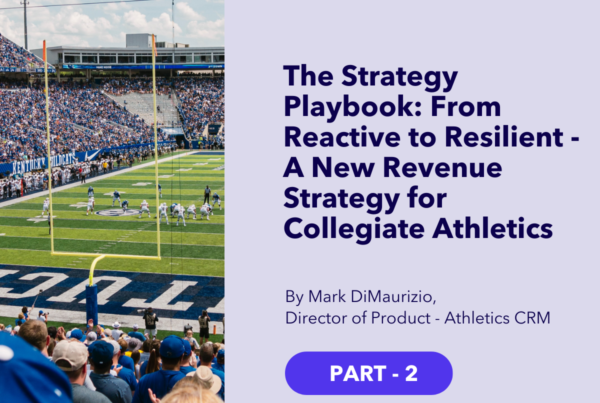By Steve Hank
When it comes to data, universities are dropping the ball.
Colleges and universities generate fantastic data about their students and alumni, as well as people who just watch their sports teams play.

Unfortunately, too many of those institutions let that data languish inside departments that don’t talk to each other, when they could be analyzing and sharing it to build better relationships with customers.
It’s ironic that academic institutions, which train young people to use technology and to collaborate, are among the slowest organizations to embrace modern data strategies and tools. And that’s a shame. Because they’re missing a chance to empower their own people with strategic intelligence and resources that they’ve never had before.
People may appear on the radar of a university because they buy basketball tickets or participate in alumni donation drives. They may have a child attending the university, a sports camp or a community event on campus. How can we embrace and then engage each one of these constituents appropriately?
We don’t want to send a barrage of messages to parents of a cheerleading camp attendee, or someone who bought tickets to a single football game. For casual contacts, it’s better to start slowly and gradually connect them with the university as a whole. Eventually, we may want to recruit the camper to apply as an undergrad. We may try to build the football fan into a mini-plan buyer, a season ticket holder and ultimately a full-fledged donor.
Personalized Attention
Reaching each of those individuals requires a very different plan. How can the university extend their initial engagement to the deepest relationship possible? Or, as described in the sports business book, The Elusive Fan, how can we move customers up the seven stages of “The Fan Involvement Ladder,” from “indifferent” to “insider” and ultimately to “ensnared.”
To grow somebody up that ladder, we have to understand who they are – holistically and at a high level. Not just in isolated chunks. To do that, we can deploy a data warehouse along with an analytics program, providing a comprehensive view of all fan interactions – through a single lens. A strong data management platform or CRM system can then coordinate constituent connections across multiple departments, streamlining and optimizing every customer contact, and increasing revenues.
Some schools have begun dabbling with software platforms and tools, either on their own or by hiring consultants. They typically take a one-off approach, addressing singular needs like handling donations, or selling tickets and merchandise.
And while these singular platforms perform critical tasks on campus, they don’t address customers over their entire lifecycle. They also miss the bigger opportunity to work together, with data that has been aggregated, cleaned, and structured to be consumed by other systems.
A Growing Opportunity
This opportunity isn’t entirely new. But it’s becoming more urgent over time. The amount of available data is growing exponentially, providing more – and more precise – knowledge about individual constituents. That lets us speak to people in their own language, with relevant, personalized messages at just the right time, that help maximize the quality of each engagement.
So why would universities resist such a fabulous opportunity? It’s a combination of inertia, fear of change and, frankly, a lack of awareness among academic leaders. Campuses are filled with people who resist change. Few people want to call out problems. We’ve always done it this way. It’s not broken. Why do we need to change?
But the technology in this case isn’t meant to change existing processes. It’s meant to make employees’ lives easier – to make smart, hard-working people, even smarter and more efficient. It can free up employees from tasks like collecting information in spreadsheets, while empowering them to add more value and showcase their broader expertise.
For example, a new workflow solution might cut 30 seconds off every phone call made by a sales rep, and two minutes off follow-up calls. How much more additional revenue could a sales rep drive if we gave her back 30 minutes a day?
Start with an Open Mind
It takes an open mindset to deploy better lifecycle management. And that begins with executive leaders, who can start breaking those institutional silos and entrenched interdepartmental politics. Leaders must understand not just the efficiencies that can be gained by mining their data for strategic insights, but also the value of speaking to customers with one voice across the institution.
That one voice means alumni no longer receive multiple phone calls, emails, direct mail, and other ads with completely generic requests for money. Whether the message comes from the law library, the development office, or the women’s basketball team, it should be coordinated to avoid duplication, and personalized to show recipients how much the university values them.
Unfortunately, many colleges and universities have yet to recognize how technology can improve their customer lifecycle management. But those that have examined the opportunity are starting to understand it and embrace it. And as the success of early movers becomes more apparent, momentum is building. They may be late to the game, but academic institutions still have time to reap the benefits of the transformative knowledge that’s now available to them.
To learn more about Central Intelligence, Advancement RM, Athletics CRM, or Affinaquest’s other data tools to help collegiate athletics and higher education advancement utilize data from across campus, schedule a demo with our expert team.




